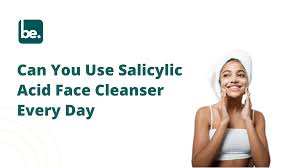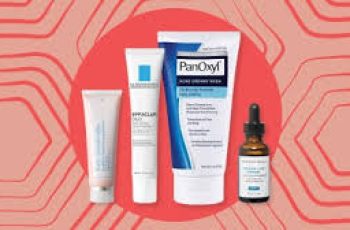
Can You Use Salicylic Acid Every Day?
Salicylic acid is the popular Beta hydroxy acid (BHA) often found blended into blemish-fighting skincare products. Compared to Alpha hydroxy acids (AHA) salicylic is oil-soluble meaning it can penetrate further down into the lower layers of the skin and help to unclog pores of any bacteria, debris or excess sebum that can develop into a spots, blackheads and other forms of blemishes. It is also a powerful chemical exfoliant, meaning it is able to slough through away any build-up of dead skin cells that often lead in the complexion looking dull, dry, lacklustre and often experiencing flaky, dry patches on the skin.
Salicylic acid can be blended into various formulations of skincare products, with serums generally containing the highest amount of potency. This makes the ingredient highly is effective at keeping the skin clear and healthy, but has gained a reputation for becoming very drying to the skin if misused or overused throughout your daily skincare routine. If you are wanting to know more about this clever BHA, you can check out our guide on the skincare benefits of salicylic acid.
Is it ok to use salicylic acid every day?
Yes it is considered ok to use salicylic acid every day, however, due to it sometimes resulting in the skin becoming irritated many skin experts and dermatologists suggest using the acid in moderation, starting by applying it 3 times a week and if there are no signs of any reactions, you can build up the usage by one or two more days. When using an over the counter product you can expect to find the percentage of the salicylic acid to be between 0.5% to 2% in strength, anything higher is found in prescription products and used in treatments performed by a trained beauty professional. Allowing enough time for the skin to adjust to powerhouse acid is the best way of avoiding any skin irritation or flare-ups.
To help you get a better understanding of how salicylic acid works on the skin and how often you should use it;
Start by using a product containing salicylic acid 3 times a week
If there are no signs of irritation you can increase the frequency you use the product
Allow your skin to adjust fully to using salicylic acid to avoid any skin reaction, such as stripping it of vital oils
If you have a dry or sensitive skin type you should avoid using salicylic acid as it is too potent for the skin
If you are still concerned with how the acid will affect your skin consult your GP or dermatologist
If you have an oily or blemish-prone skin try applying a serum containing salicylic acid during your evening routine as this allow more time for the ingredient to combat any skin concerns while you sleep
Always perform a patch test for 24 hours before applying any product to your skin
Ensure you always apply a daily SPF of 30 and above to protect the skin from harmful UV ray damage
There you have some helpful tips about how to use salicylic acid and the precautions you have to make when introducing it into your skincare routine. If it is breakouts and spots in particular you are wanting to target you can find out more in our blog post about how to treat breakouts with salicylic acid.
How often should you use salicylic acid?
You are able to use salicylic acid twice daily, but only after your skin has built its tolerance. Oily and acne prone skin will benefit from frequent application, however precautionary actions should always be followed when using this potent ingredient. When considering how often you should use salicylic acid can begin with the type of skincare product you decide to use, face wash for example, generally contains a lower percentage of the exfoliant and including the fact you have to rinse it off you are able to use it every day. Remembering of course to keep an eye on how your skin is feeling and looking to avoid irritation.
As for acid toners they generally remain on the skin for longer amount of time and contain a higher level of acid in their formulations, they can however be used daily if your skin is happy for you to do so. Toners enriched with chemical exfoliants, such as BHA, are hugely beneficial for the skin and can slough away the barrier of dead skin from the face resulting in optimal product skin penetration. Over the counter serums contain the highest percentage and should only be used 3-4 times a week allowing the skin to reap the rewards without it becoming too harsh.
Face Cleanser & Gel containing 0.5-5% use once per day
Lotions containing 1-2% use 1 to 2 times a day
Blemish Ointments containing 3-6% use as needed topically on blemishes
Exfoliating Pads containing 0.5-5% use 1-2 times a day
All Over Solutions containing 0.5-2% use 1-2 times a day
What are the side effects of salicylic acid?
The most common side effects you can experience when using salicylic acid are;
Stinging or burning sensation when you first apply the product the skin that can last for over 5 seconds
Tightness and dryness to the skin from using a product that is too potent for your skin type
Flaky, red patches of skin
Breakouts of acne and spots due to the skin becoming stripped of essential sebum
If you experience any swelling, blistering or rashes on the skin you should stop using the product immediately and seek the help from a doctor
If you find yourself overusing any of these products mentioned you may find your skin becomes tight and uncomfortable, this is due to the skin’s natural protective barrier becoming damaged with the vital oils and water being stripped from the skin by the exfoliating acid.
When should I stop using salicylic acid?
You should stop using salicylic acid if you find your skin to be prone to frequent breakouts then using salicylic acid should become a regular step in your skincare routine. By teaming the chemical exfoliant with a number of other skincare ingredients you will create a cocktail of products which will give you the most healthy and happy skin.
Here are some examples of skin ingredients that will compliment and help the skin look its best;
Hyaluronic acid
Niacinamide
Vitamin C
Glycolic acid
Lactic acid
Retinol
All of the ingredients are very potent and some, such as retinol and glycolic acid must be introduced into your routine slowly and only once you have been given the go ahead from a dermatologist or skincare professional. Finding the right routine for you is not an easy task and it may take you a couple of goes at finding the best formulas and products for you, once you do, you will have the most luminous, clear and youthful skin.
Is it normal to breakout after using salicylic acid?
Yes, potent ingredients such as salicylic acid can often result in a flare-up of irritation and negative skin reactions. This is normally due to the increase of the exfoliation of dead skin cells which can often cause dryness and discomfort.
You may also find that you suffer from frequent breakouts and blemishes as salicylic acid works deeply in the pores. It will then push all the unwanted “gunk” to the surface of the skin resulting in various spots and breakouts, such as blackheads and whiteheads. These blemishes will appear after the first couple applications and will begin to subside after 4 weeks. If however, you find there’s no improvement, stop using your salicylic acid product and seek the advice of your doctor or dermatologist.
There you have a little more details about using salicylic acid and how to use it every day, don’t forget to come and give our Instagram a follow to find out more.


